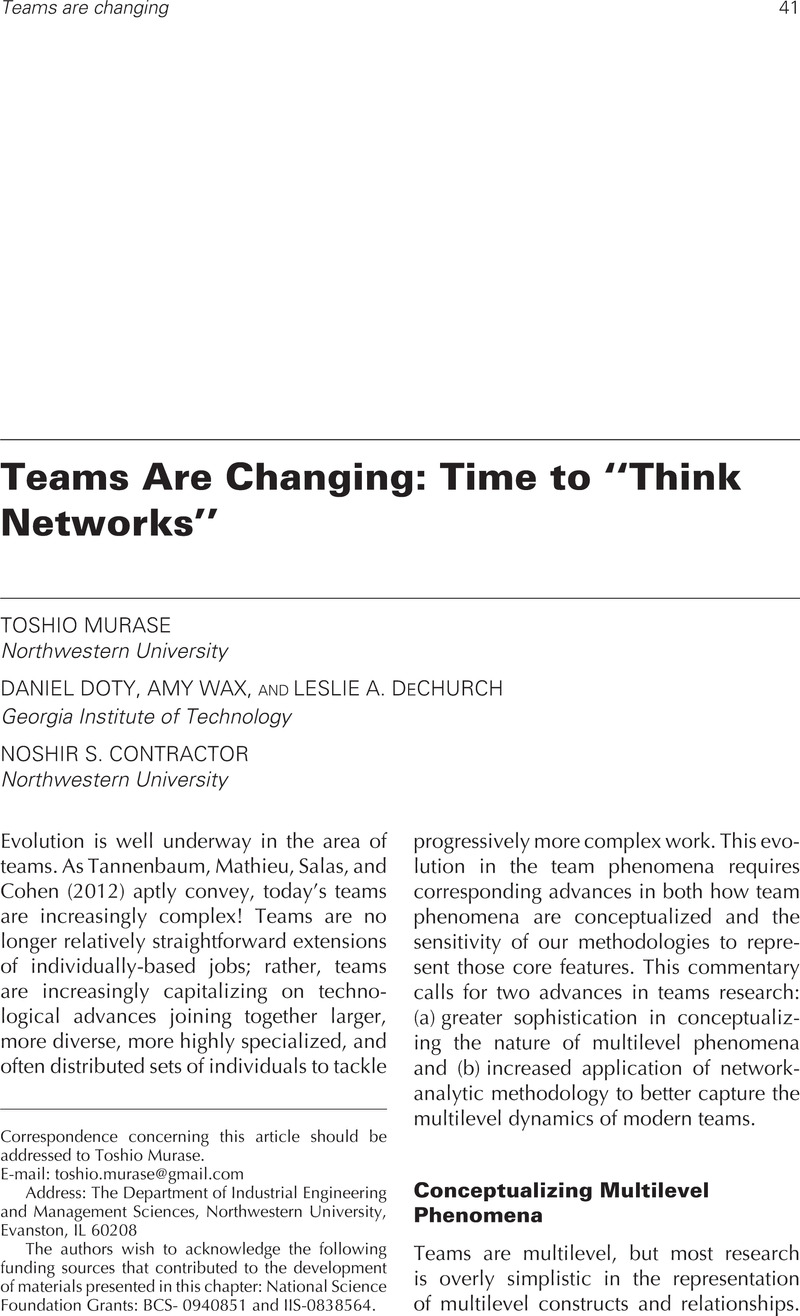Crossref Citations
This article has been cited by the following publications. This list is generated based on data provided by Crossref.
Roe, Robert A.
Gockel, Christine
and
Meyer, Bertolt
2012.
Time and change in teams: Where we are and where we are moving.
European Journal of Work and Organizational Psychology,
Vol. 21,
Issue. 5,
p.
629.
Tannenbaum, Scott I.
Mathieu, John E.
Salas, Eduardo
and
Cohen, Debra
2012.
On Teams: Unifying Themes and the Way Ahead.
Industrial and Organizational Psychology,
Vol. 5,
Issue. 1,
p.
56.
Mortensen, Mark
2012.
From Teams to Recombinant Collaboration: Understanding the Evolution of Organizational Work.
SSRN Electronic Journal,
Detert, James R.
Burris, Ethan R.
Harrison, David A.
and
Martin, Sean R.
2013.
Voice Flows to and around Leaders.
Administrative Science Quarterly,
Vol. 58,
Issue. 4,
p.
624.
Aydinoglu, Arsev Umur
2013.
Toward a New Understanding of Virtual Research Collaborations.
Sage Open,
Vol. 3,
Issue. 4,
Crawford, Eean R.
and
LePine, Jeffery A.
2013.
A Configural Theory of Team Processes: Accounting for the Structure of Taskwork and Teamwork.
Academy of Management Review,
Vol. 38,
Issue. 1,
p.
32.
Coultas, Chris W.
Driskell, Tripp
Burke, C. Shawn
and
Salas, Eduardo
2014.
A Conceptual Review of Emergent State Measurement.
Small Group Research,
Vol. 45,
Issue. 6,
p.
671.
Hesketh, Beryl
and
Graco, Warwick
2015.
International Encyclopedia of the Social & Behavioral Sciences.
p.
104.
Mendez, Maria J
Howell, Jon P.
and
Bishop, James W.
2015.
Beyond the unidimensional collective leadership model.
Leadership & Organization Development Journal,
Vol. 36,
Issue. 6,
p.
675.
2015.
The Concise Encyclopedia of Communication.
p.
397.
Mortensen, Mark
and
Haas, Martine
2016.
Rethinking Team Boundaries.
SSRN Electronic Journal,
D’Innocenzo, Lauren
Mathieu, John E.
and
Kukenberger, Michael R.
2016.
A Meta-Analysis of Different Forms of Shared Leadership–Team Performance Relations.
Journal of Management,
Vol. 42,
Issue. 7,
p.
1964.
Fodor, Oana C.
and
Flestea, Alina Maria
2016.
When fluid structures fail.
Team Performance Management,
Vol. 22,
Issue. 3/4,
p.
156.
Murase, Toshio
Poole, Marshall Scott
Asencio, Raquel
and
McDonald, Joseph
2017.
Group Processes.
p.
119.
Weber, Charles M.
and
Mayande, Nitin V.
2017.
Knowledge Flows and Influence in Online Social Networks: Proposing a Research Agenda.
p.
1.
Mortensen, Mark
and
Haas, Martine R.
2018.
Perspective—Rethinking Teams: From Bounded Membership to Dynamic Participation.
Organization Science,
Vol. 29,
Issue. 2,
p.
341.
Benishek, Lauren E.
and
Lazzara, Elizabeth H.
2019.
Teams in a New Era: Some Considerations and Implications.
Frontiers in Psychology,
Vol. 10,
Issue. ,



